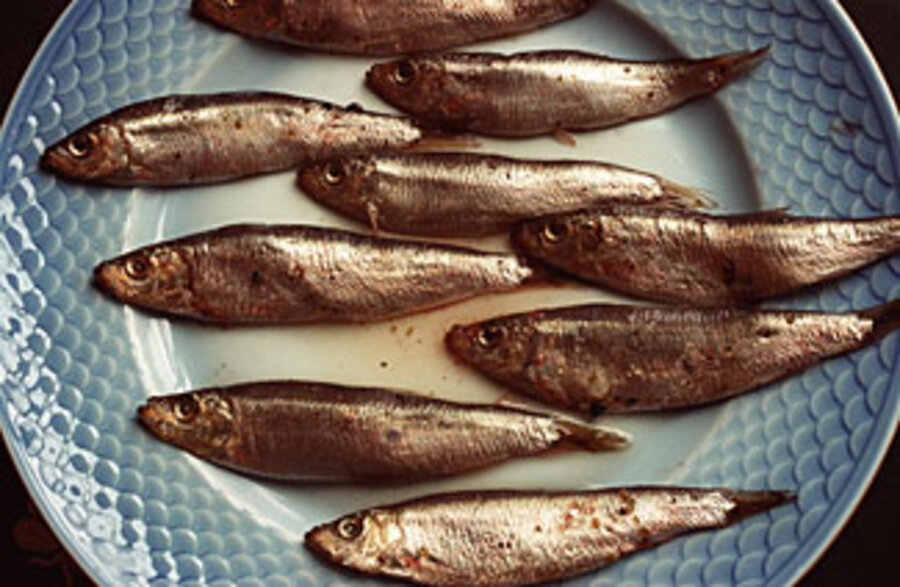Simple, savory sardines
Loading...
While looking for some long-lost birdseed recently, I found an old package of crackers in the back of the room we call our pantry. It had been part of a gift basket from a couple of Christmases ago but was still sealed and showed no sign of having been nibbled on by mice. I announced my find to my wife, Jeannie, who cautioned me that they might have gone very stale over the years.
"No problem," I announced, "I'll take them to work and eat them with sardines. That will hide any stale taste."
"Two wrongs don't make a right," cautioned Jeannie, who does not share my enthusiasm for sardines.
I'm not sure whether I like sardines or the places sardines make me think about. The heavy, oily, fiercely fishy taste of canned sardines can be wonderful on the right kind of day. On a hot summer day, with the south wind blasting, a tin of sardines on crackers with a couple dozen sharp capers and a bottle of tart cranberry juice make a great lunch. Some days, I'll admit, the thought of so thoroughly fishy a fish is more than I want to contemplate.
Even on days when sardines are just too heavy a meal to eat, the idea of them still transports me to magical places. The North American sardine industry once thrived up and down the coast of Maine and New Brunswick. Throughout the first half of the 20th century, new canneries popped up in little towns up and down the coast.
Fishermen caught young Atlantic herring in simple barriers of branches and net, called weirs, strung across tidal bays. Graceful sardine carriers (80-foot wooden boats pointed at both ends) hurried the catch to canneries where workers, many of them young children, whisked them into cans to be sold as sardines. The whole industry depended on the deep coves and high tides that give the coast of Maine and New Brunswick much of its charm. The California fishery that John Steinbeck made famous in "Cannery Row" started later and ended earlier than the industry in Maine.
So when I open a tin of sardines, I can imagine the coast of Maine. In fact, I can see the cannery where those sardines come from. It sits at the head of a deep cove in the town of Gouldsboro, east of Acadia National Park in the part of the Maine coast where factories can still compete with resorts for idyllic waterfront land. A couple dozen fishing boats are moored just in front of the cannery. Out back is the conveyor belt from which local lobstermen and bait dealers load huge tubs of cast-off herring that they salt and use to bait lobster traps.
If my can of sardines says "Product of the USA," they must be the product of the Beach Cliff cannery at Gouldsboro. Of the dozens of canneries along the Maine shore as late as the 1950s, it is the only one to survive. After World War II, Americans' taste for sardines almost vanished. As highways improved and almost every household acquired a refrigerator, our ability to transport and store fresh fish increased. Quickly frozen fish and fish sticks flooded the market. An oily, smelly, canned fish that many consumers associated with hard times or military rations could not compete.
Between 1950 and 2000, the herring catch declined drastically and much of what was caught was diverted to make fertilizer or lobster bait. One by one the canneries closed, forced out by falling demand and the difficulty of finding enough workers to fill the dangerous and unreliable cannery jobs.
A tin of sardines is still a treat. The strong flavor holds up against other potent tastes such as onion, capers, Worcestershire sauce, and sharp mustard. It's a food for those times that demand strong tastes, when only assertive flavors can be satisfying. And sardines are a food to transport us to pretty places where hard-working people still make a living from the sea.
Sardine Sandwiches with Lemon-Basil Chickpea Spread
This creamy basil chickpea spread stands up to and complements the strong flavor of sardines. Even sardine haters might like this sandwich.
In the winter, substitute 1/2 cup of chopped green-onion tops for the basil. Wait to add green onion until chickpea spread is creamy; then pulse until onions are mixed in.
Any leftover chickpea spread makes a delicious dip with pita bread or vegetables.
Chickpea Spread:
2 large garlic cloves, peeled
1 (15-ounce) can chickpeas, rinsed and drained well
1-1/2 tablespoons extra-virgin olive oil
1-1/2 tablespoons lemon juice
1-1/2 cups packed basil leaves
Salt to taste
Drop garlic cloves through feed tube of food processor with blade spinning. Stop processor and scrape down sides.
Add chickpeas, olive oil, and lemon juice and pulse until chickpeas are chopped.
Add basil and process, stopping to push down basil and scrape down sides, until mixture is creamy. Add salt to taste.
Sandwich:
2 (3-3/4-ounce) cans brisling sardines, packed in water
4 sesame-seed bagels, split
Chickpea Spread (see recipe)
4 slices of red onion
4 curly lettuce leaves
Drain sardines and wrap in a double layer of paper towels to blot dry. If sardines are thick, split in half lengthwise.
Toast bagels and spread bottom halves with Chickpea Spread.
Arrange sardines, onion slices, and lettuce leaves on top of Chickpea Spread.
Top with bagel halves.
Makes 4 servings.
Source: Jeannie McDermott





